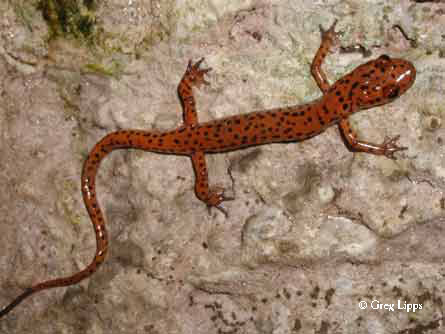
Cave Salamander
(Eurycea lucifuga)
 |
 |
|
|
Distribution of the Cave Salamander (from the AR MI Atlas)
|
An adult Cave Salamander.
|
|
Description: A long (5-8”), slender salamander, with a ground color ranging from orange to red. Irregular black spots pepper the body and tail. Unlike the closely related Long-tailed Salamander, the spots do not form bars on the tail of the Cave Salamander. The tail is long, making up 60-65% of the total length. The head and body have a somewhat flattened appearance. |
||
Distribution in Ohio: Documented in the southwestern counties of Hamilton and Butler, and in Adams County in southcentral Ohio. |
||
|
|
||
Status in Ohio: The Ohio Division of Wildlife lists the Cave Salamander as ENDANGERED. |
||
|
|
||
Habitat: Found in and around caves, springs, springhouses, and small limestone streams associated with groundwater. Cave salamanders may be found in rock crevices or under rocks, logs, and other debris. |
||
|
|
||
Life history: Courtship probably occurs in autumn. In the winter, eggs are attached singly to rocks in underground springs or in small streams and probably hatch the following spring. The aquatic larvae go through metamorphosis the following summer. Sexual maturity is reached 2-3 years later. |
||
|
|
||
Conservation: Cave salamander populations rely on sources of groundwater, such as springs, seeps, and headwater streams, and limestone areas associated with these areas. Their permeable skin makes them especially susceptible to pollution, such as pesticides, herbicides, runoff, and acid mine drainage. Removal of trees around springs, seeps, and headwater streams may negatively impact populations by increasing temperatures and evaporation. Forested areas around these water sources are also important for foraging. |
||
Last modified:
|
Ohio Amphibians · Ohio Salamander Web · Ohio Salamander Species · Amphibian Habitats · Salamander Monitoring |
|